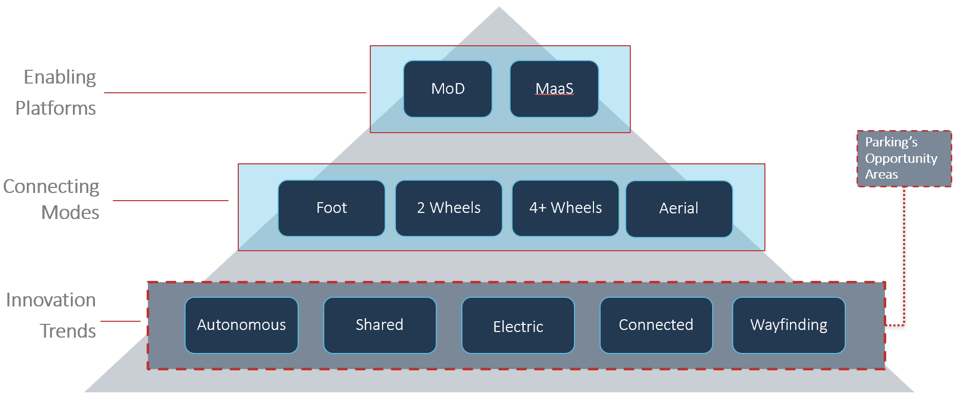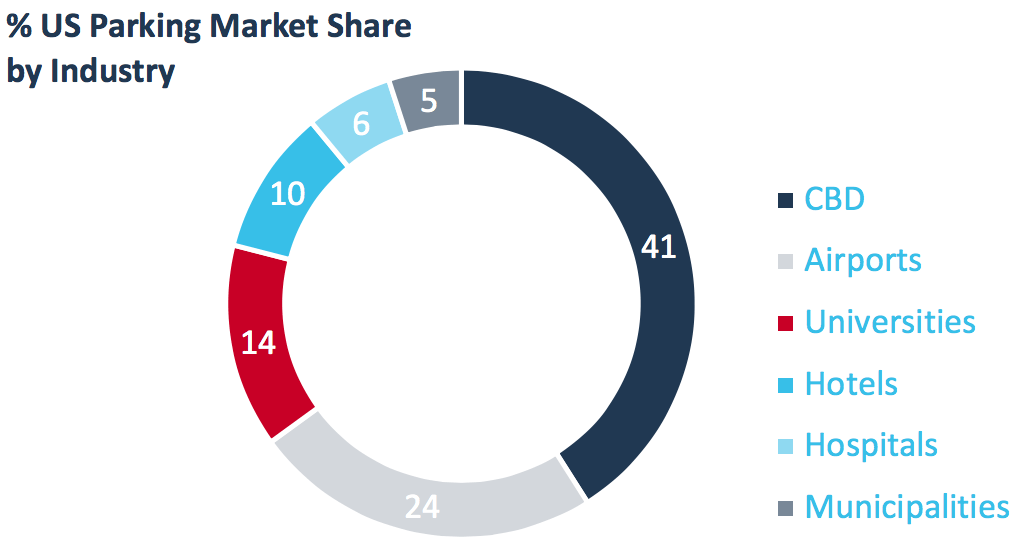A Space for Parking in the Future of Mobility
As space within the mobility innovation ecosystem becomes increasingly complex, innovators seeking to disrupt the way we move around cities are taking calculated risks on future commuter choices. City authorities are also faced with the dilemma of implementing policy and incorporating innovative new strategies that adapt to changing commuter demands. The parking industry is uniquely aligned to complement many expected technological and behavioral changes that can be leveraged to expand equitable access and increase performance of transportation services as the future of mobility evolves.
Parking’s Spot within New Mobility Trends
Speculation on what concoction of platform, transit mode, and innovation is inevitably adopted by the majority of commuters is contentious among industry experts. Less contentious, given the recent clashes over the curbside and overnight e-scooter rollouts across the country, is that most scalable disruptions to mobility need adaptable physical space to operate – an increasingly scarce resource in densifying cities – and a resource that the parking industry can provide.
Unlocking Mobility’s Innovation Potential within Parking
Parking is a $30 billion-a-year industry[1] that has maintained a symbiotic relationship with traditional auto-centric mobility within cities. Now faced with the same need to adapt due to declining forecasts of private car-ownership from what experts have coined the global mobility revolution, there’s reason to believe there is plenty of space for parking within the mobility innovation ecosystem. Traditional uses of parking and parking garages will be completely changed by increasing e-commerce, the rise of fleets and micro-mobility, and increasing demands for electric charging, among others. Unlocking much of this potential is the rise of 5G, indoor mapping, and increased underground connectivity innovation currently underway in the parking industry. Given the necessity for parking to evolve, here are a few ways the parking industry can innovate and leverage their physical presence to help solve some of the crucial issues within the evolving mobility landscape.
Future Mobility Hubs
Mobility systems are the circulatory system of cities.
Rather than easing or slowly chipping away at congestion within the system, innovation
in mobility has often sought to disrupt the system entirely. This has often
left cities with excess congestion and pieces of metal lodged in key arteries. Parking
has already made advances in revenue collection measures and easing its
self-contained congestion within lots themselves. What if the same impact could
be done on a larger scale for cities?
As advances are made to curbside pricing and management, centrally
located parking garages can be utilized as alternate TNC pick-up/drop-off hubs.
Additional micro-mobility units can then be used for first/last mile
connectivity. In less dense areas with longer commute times, parking garages
can be utilized as key nodes in larger transportation networks where evolving
demand models can optimize route schedules and planning.
Freight/Logistics Centers for First/Last Mile Deliveries
Similar to the process of moving commuters around, freight and package deliveries can utilize secure storage and access points that are closer to their end destination or consumer. While cities have banned larger trucks from entering key congested corridors, parking garages can provide temporary staging locations for freight and packages, freeing up warehouse space on the outskirts of cities. In the industrial era, freight and shipping naturally sprang up from urban cores due to the operational efficiency of location. While scale forced many operators to urban peripheries, utilizing parking as staging hubs has the potential to increase efficiency of freight and package deliveries. This is especially crucial given the vast growth of e-commerce and the “Amazon-effect” of induced congestion on curbsides and city-centers.
EV-Fueling Stations & Advances in Microgrid Technology
Whether you’re in the shared, autonomous, or connected mobility
camps, one thing we can all agree on is that the next major automotive
revolution (after shared) will be electric. While the need for filling gas will
subside, EVs still need to recharge. Unless charging technology makes drastic
advances, herein lies an interesting challenge where demand for electric
charging stations will exceed the supply that retrofitted gas stations can offer
– picture lines outside gas stations during the 1970’s energy crisis. When
factoring autonomous technology embedded within electric cars, even more unique
opportunities for self-servicing vehicle stations come to mind.
While more environmentally sustainable and cost-effective
than traditional fossil fuel cars, large-scale adoption of EVs will also
require vast upgrades to overloaded electric grids. Just as a sweltering hot
summer can overburden a city due to increased energy consumption from air
conditioners, imagine what it would take to power the roughly 1.3 million cars registered
in Chicago[2]. Additional distribution centers and micro-grids will be necessary to
accommodate this additional demand. Parking garages can serve as EV charge-points
and storage facilities, providing the electric utility infrastructure necessary
to support a large-scale EV rollout.
Innovation within Parking
The innovation ecosystem doesn’t stop exclusively at mobility. Given the parking-specific advances of mobile booking and gateless entry, parking itself is rife with innovation opportunity. When partnered with autonomous vehicles, parking valets can fit more cars within tighter spaces, allowing operators to maximize revenue within lots. Autonomy also drastically expands the reach of where people park, allowing developers to forgo onsite parking restrictions in favor of increased density and more affordable housing units if mandated.
Parking as Flexible Space
When factoring in the modular form of parking garages, the potential for adaptive reuse cases expands the possibility of how parking can be reimagined. Space has become a sparse resource in densifying cities. As companies and individuals vie for limited storage and office space, certain parking facilities are well equipped to accommodate mixed uses such as storage, office, or retail space within their existing typologies. Parking also has the potential to be programmed as cultural space – bridging the longtime segregation of parking garages and lots by utilizing it as public space for social events.
Wrap-up
Given its applicability to growing mobility trends, the parking industry deserves a spot within the innovation ecosystem. Just as the car needed the physical infrastructure of parking to expand across the country and the rest of the world, the future of mobility similarly depends on physical infrastructure to expand. New IoT technology and increased connectivity can enable the parking industry to become a partner in the mobility revolution– except this time under goals of creating less congested streets and increased accessibility to sustainable transport.
About the Author: Firas Suqiis the Manager of the Advanced Mobility Initiative and Millennium Gateway Innovation Lab at City Tech Collaborative. Firas leads the solution development pipelines for both the Initiative and the Lab, including assembling the cross-sector teams necessary to create new solutions to complex urban mobility challenges. Prior to joining City Tech, Firas was a Mobility Expert at UN-Habitat, where he worked on strategizing large-scale urban mobility and infrastructure projects across emerging megacities. Firas is a native Chicagoan with experience working in over a dozen cities across four continents. He holds a master’s in Urban Planning from Harvard University’s Graduate School of Design in addition to a Bachelor’s in Anthropology & Sociology from Knox College.
Sources:
[1] International Parking Institute, “ Overview of the US
parking industry
,” accessed March 2, 2020.
[2] Chicago Tribune, " Chicago unveils new parking stickers," accessed March 2, 2020.

